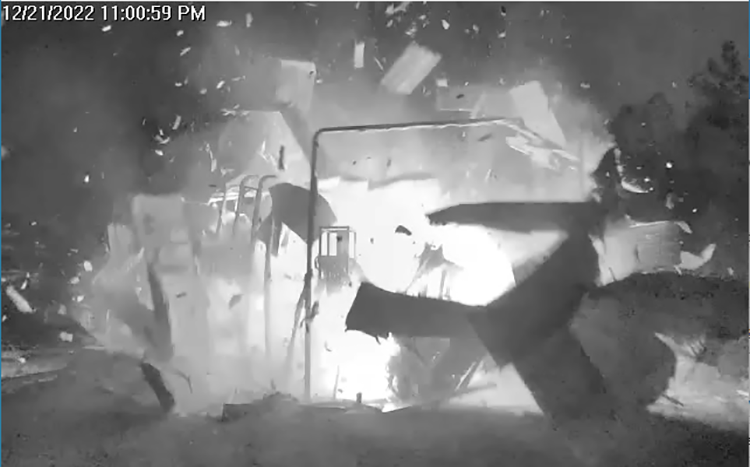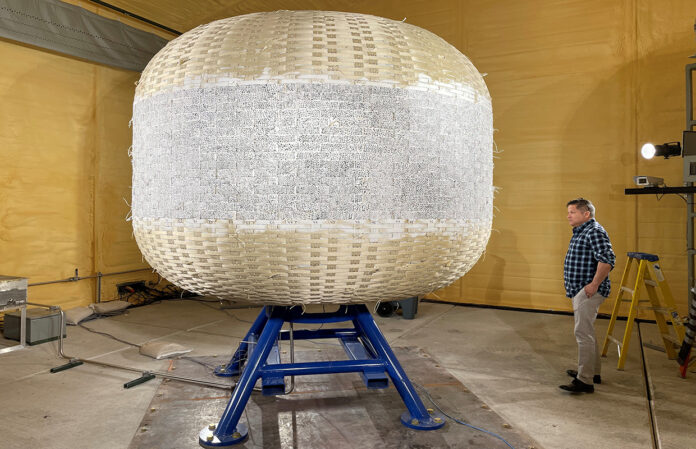LOUISVILLE – Sierra Space just released video of the successful third stress test – this time for duration – performed at the Marshall Space Flight Center in December on its Large Integrated Flexible Environment. The test exceeded NASA certification requirements, demonstrating the inflatable structure’s integrity for sustaining human life in space for long periods of time.
Sierra Space’s LIFE is a key component of the company’s in-space destinations technology. The inflatable module is a three-story, commercial habitation and science platform designed to allow humans to live and work comfortably in low-Earth orbit and beyond.
LIFE will serve as the habitation and payload element for the Orbital Reef commercial space station, a collaboration between Sierra Space and Blue Origin.

December’s creep test is different from the tests in July and November.
This latest assessment, called an Accelerated Systematic Creep Test, tests whether the unit’s “softgoods” pressure shell could last during its on-orbit operational mission life. This test pressurized units with increasing loads until they burst at maximum or Ultimate Burst Pressure.
High-strength softgoods materials are sewn and woven fabrics – primarily Vectran – that become rigid structures when pressurized and can provide safe and sustainable architecture for space habitation.
The destructive materials testing involved loading the test unit – a subscale version of the inflatable habitat – with a sustained amount of pressure over time until it fails.
NASA designed a climate-controlled disposable building in which the test was performed. It had to meet two requirements: One – to protect the test article (Sierra Space’s pressure shell) during the duration of the test; and two – to be expendable once the article successfully burst upon maximum creep pressure and duration.
Due to the explosive nature of the test, the team placed the sub-scale space habitat adjacent to the flame trench of the Saturn 1/1B test stand.
The pressure shell burst after more thanr 150 hours, exceeding NASA’s short-term, recommended creep duration target of 100 hours, proving astronauts could live and work in a full-size version of the inflatable habitat for 60 years in space.
“Sierra Space’s LIFE pressure shell has an on-orbit performance requirement of 15 years, but with softgoods, there is a ‘times four’ safety requirement set by NASA, so we must ultimately prove we’re viable for 60 years,” said Shawn Buckley, LIFE chief engineer and senior director of Engineering at Sierra Space. “Based on data from this first subscale creep test, we well exceeded the on-orbit mission performance requirement of 60 years for inflatable structures within our current architecture.”
Sierra Space CEO Tom Vice said LIFE represents the essential technology developments needed to one day enable humans to live and work in space.
“Habitat units are a key element in Sierra Space’s platform in space, and this crucial milestone illustrates that our team has exceeded programmatic requirements that validate critical aspects of the LIFE design,” he said
“These results will propel us in 2023 as we mature the technology via full-scale development and continue toward full NASA certification.”
All three tests took place within six months. The testing is a key step in facilitating extended human missions to low-Earth orbit, the moon and Mars.
The company will conduct a second subscale Systematic Accelerated Creep Test early this year. Stress tests on full-scale LIFE units will begin later in the year as part of Sierra Space’s ongoing softgoods certification process.
Sierra Space performed the 2022 subscale Ultimate Burst Pressure Tests as part of NASA’s NextSTEP Appendix A Habitat Systems contract, which is managed by Marshall and falls under the pre-formulation habitation team in the agency’s Explorations Systems Development Mission Directorate Technical Integration office.
The Systematic Accelerated Creep Test was performed by Sierra Space under its LIFE softgoods certification.
Don’t miss out! Subscribe to our email newsletter to have all our smart stories delivered to your inbox.



